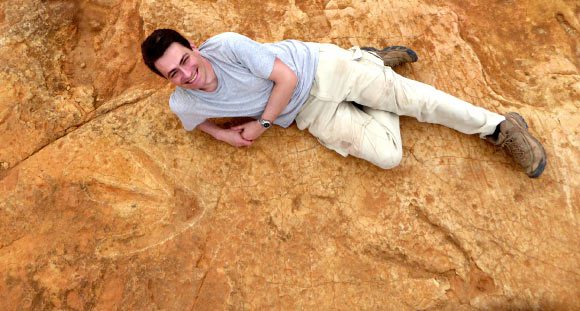Footprints of a previously unknown, very large carnivorous dinosaur have been found on an ancient land surface — known as a palaeosurface — in the Maseru District of Lesotho, Africa.
Dr. Knoll lies next to the exceptionally large carnivorous dinosaur footprints found in Lesotho. Image credit: Fabien Knoll.
The newly-discovered three-toed footprints, named Kayentapus ambrokholohali, are 22 inches (57 cm) long and 20 inches (50 cm) wide.
They belong to a megatheropod (giant two-legged carnivorous dinosaurs, such as the iconic Tyrannosaurus rex) that lived 200 million year ago in southern Africa.
University of Manchester paleontologist Fabien Knoll and co-authors estimate that the dinosaur was a little less than 10 feet (3 m) tall and 30 feet (9 m) long, which is smaller than T. rex.
“This discovery is very exciting and sheds new light on the kind of carnivore that roamed what is now southern Africa,” Dr. Knoll said.
“That’s because it is the first evidence of an extremely large meat-eating animal roaming a landscape otherwise dominated by a variety of herbivorous, omnivorous and much smaller carnivorous dinosaurs. It really would have been top of the food chain.”
What makes the discovery even more important is that these footprints date back to the Early Jurassic epoch, when it was thought the size of most theropod dinosaurs was considerably smaller.
On average they were previously thought to be around 10-16 feet (3-5 m) in body length, with some records showing they may have reached 23 feet (7 m) at the very most.
It is only much later in the Jurassic and during the Cretaceous, which starts 145 million years ago, that truly large forms of theropods, such as T. rex, appear in body and trace fossil records.
“This discovery marks the first occurrence of very large carnivorous dinosaurs in the Early Jurassic of southern Gondwana,” said Dr. Lara Sciscio, a postdoctoral researcher at the University of Cape Town.
“This makes it a significant find. Globally, these large tracks are very rare. There is only one other known site similar in age and sized tracks, which is in Poland.”
The ancient surface where these footprints were found is also covered with the tracks of much smaller theropod dinosaurs.
“In South Africa, Lesotho, Zimbabwe and Namibia, there is good record of theropod footprints from the Late Triassic and Early Jurassic epochs,” Dr. Knoll said.
“In fact, there are numerous palaeosurfaces where footprints and even tail and body impressions of these, and other animals, can be found. But now we have evidence this region of Africa was also home to a mega-carnivore.”
A paper reporting this discovery is published in the journal PLoS ONE.
_____
L. Sciscio et al. 2017. The first megatheropod tracks from the Lower Jurassic upper Elliot Formation, Karoo Basin, Lesotho. PLoS ONE 12 (10): e0185941; doi: 10.1371/journal.pone.0185941
Source link : https://www.sci.news/paleontology/megatheropod-dinosaur-footprints-lesotho-05363.html
Author :
Publish date : 2017-10-26 03:00:00
Copyright for syndicated content belongs to the linked Source.
